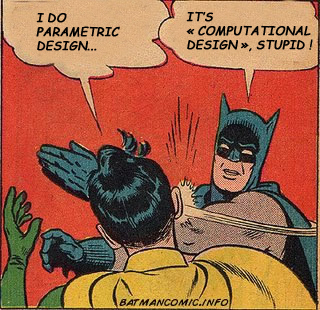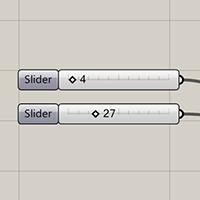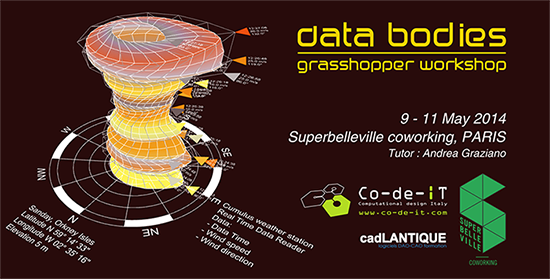There is big trend about parametric approach and computation in design and architecture. In the last months, I’ve repeatedly been involved in discussions about if it would be more exact to call what we do as designers “computational design” or “parametric design”. It is not a useful discussion, I have to say.
I have the feeling that computational design is more trendy and parametric design is more nineties, would you agree with that ? As Aldo from Noumena Architecture said during our last workshop : “Don’t say parametric design!”.
But what is the difference between “parametric design” and “computational design” ?
I don’t know. “Computational design” refers to the use of computers and mathematical approach to the generation of geometries, objects and architecture. “Parametric design” is about using parameters to design things. It means that if parameters changes, the result change. Regardless of which expression is the best, what interests me the most is the idea of focusing on design process instead of designed objects.
the most interesting shift in design is that we have passed from designing object to designing networks and processes http://t.co/iwg54WHo
— Francesco Cingolani (@immaginoteca) September 29, 2012

The process is everything
The process is everything (Mies would say that “God is in the process”) and that’s why I think that “parametric design” is still an interesting way to explain our approach. Parameters is about changing conditions and adaptability to user needs. We need to design process instead of objects.
François Roche recently published on his blog our emails exchanges about these topics. If you know him a bit, you would not be surprised to see that he’s not very polite. If you don’t speak French, try to google translate the post.
François Roche says that “computation is a good think, not parametric design…it’s like confusing science with the power of science”.
I answered “Personally, I’m more interested in action than language.”
I use both.
I like to shuffle things and confuse myself and the others, so I use both expressions. In English I mainly define myself as a computational designer, but working in France, I tend to use “Architecture Paramétrique” and “Design paramétrique” because there is no right word to translate computational (I don’t like architecture numérique). Let’s give some examples.
Actually, the name of my computational design course in Marne La Vallée architecture school in Paris is “Architecture Paramétrique” and one of the platform I use to promote my computational design workshops is architectureparametrique.com.
At Hugh Dutton Associates and on complexitys.com we use mainly “parametric design” or “performance-driven design” because we think that our role as designers is to pick parameters and information streams and let them converge to a project (designer as a medium).
What about Andrea Graziano ?
I used the image above to introduce REaction 1401 workshop last week-end and I will use it again to introduce our next international workshop with Andrea Graziano, DATA BODIES, taking place in May.
I’ve already had this discussion with Andrea, one of the most influent computational designers in Italy and Europe : he doesn’t like when I say he’s a parametric designer :)
Do you want to join the discussion about computational VS parametri design?
Leave a comment or register for the workshop !
Bodybuilding med bodybuilding-videor: mr. Olympia helgen 2009 trenbolone enanthate köp clenbuterol bodybuilding steroider – drainagefulham.


Absolutely right. There is nothing called parametric design; only parametric CAD.
What bothers me with the use of “parametric design”, and as you pointed out, this is the anti modernist vision purely process oriented. Although I love parametric, for me it’ s only a tool, not a purpose. Creating architecture (not just designing but building it) is more than just simply follow a process. The advantage of the “computational word” is that it removes this value. After in French, it’s more complicated because, you’re right, “architecture computationnelle ” is weird and maybe we should find a good translation.
Provocative title but you didn’t go anywhere with it. Focusing on a semantic disambiguation underpinned by linguistics could be an interesting starting point. But I wonder if any of these adjectives (computational, parametric, generative, numerique, etc) truly adds any validity to “design”, as in a design model? otherwise what is it intended to be gained by it? are they truly methodologies or simply tools?
Clarity of language is necessary for clarity of argument. Therefore, if we were to dismiss the importance of the precise meaning of words we also dismiss the importance of having any meaningful discussion. What is the point of a blog without meaningful words?
Computational design is more than designing with computers. Computational design is about (conscious, purposeful) use of mathematical methods (including geometry, algebra, etc.) in the design process. Parametric design uses parameters, i.e. variables with constant values (per dictionary), which in computer-based design usually becomes equivalent to designing using variables. Variables are objects in computational design; therefore, parametric design as a term focuses on a specific aspect of computational design and is perhaps a subset of computational design. There is a definition for “generative design” by Celestino Soddu: “Generative Design is a morphological approach that identifies the “modus operandi” of formal transformations during time, and using algorithms, writes the rules of the dynamic and chaotic system that draws the architecture and town image development” (Citta’ Aleatorie, published in 1989).
@Sivam: Interestingly enough, any proportional system (or the classical column orders) are examples for both, computational and parametric design(!) (way before Computer Aided Design). I suggest that this rich design tradition is worth keeping in mind.
Therefore, yes, these terms describe design methodologies which for clarity of debate are labeled as if they were complete entities; however, in most design processes they are part of an overall design methodology and should be used to contribute to the design when it makes sense.
As the author of “Parametric Design for Architecture” :) I will have to disagree. There is definitely a difference between what I call Parametric Design and “Algorithmic Architecture” or “Algorithmic Architecture”. Colleagues may also argue that there is something else called “Generative Design”. In my book (sorry I do not mean to plug it, but I have carefully thought through these things), I define parametric design as such:
Parametric Design is a process based on algorithmic thinking that enables the expression of parameters and rules that, together, define, encode and clarify the relationship between design intent and design response.
The fact that it is a process is clear. It is a way of thinking. Actually a fundamental shift in thinking of how we go about designing. The main shift is one from a high fidelity in the manifestation of design concepts to a high fidelity in the expression of the logic of design concepts. To use a metaphor, it is a shift from focusing on the face of a watch, to a focus on the internal mechanics of the watch.
I disagree that it is “just a tool”, but I do agree that it should also not be the “purpose” of a design. Parametric Design is a shift in thinking of how we get from design intent (what we want to do) to design response (how we go about doing it).
(I meant to type “Algorithmic Architecture” vs. “Algorithmic Design” in the previous post).
hi francesco,
as always, interesting material. i’ll throw in.
i can’t say that i have spent a lot of time on this but there is a similar discussion with respect to what one calls rapid prototyping and the various processes that enable it. ultimately some terms i’ve seen seem hopelessly soulless and others equally facile.
HDA’s use of “performance driven design” is interesting and on point – particularly in the sense that the intent is to get the building or structure to perform well. that said, it is a little unwieldy and – i suppose – some architects do in fact use these tools because they just want the thing to look cool and aren’t as interested in the performance or buildability in terms of their approach (at least initially). in that sense they would use the tools to make something look cool and they or someone else would come around later and post-rationalize it (using basically the same computer-centric approach) – in order to make it buildable and/or performative.
also, i like guillame’s point about architecture needing more than simply one element like design process and in that sense i would say that the use of “design” is lacking in that it only encompasses a small part of architecture. “parametric architecture” or “computational architecture” or even “scripted architecture” all seem to me to mean essentially the same thing and all of them are lacking in some way.
that said, after having read patrik schumaker’s writings on the topic i find them well-reasoned and coherent and in this sense i can live with “parametric architecture” for at least awhile. also, it seems to take into account the ideas of ‘scripting’ (coding for form which is based upon parameters) and ‘computational’ (anything from creating mathematical shapes to analyzing solar performance in the computer is going to basically be based upon various parameters) and in my mind “parametric” is wide enough that it could be applied to everything from wild and initially unbuildable form creation, to pre-rationalized form creation that is inherently optimized – on down the line to the analytical tools designed to post-rationalize for constructibility or optimize for energy usage (or other needs).
best,
– jonathan